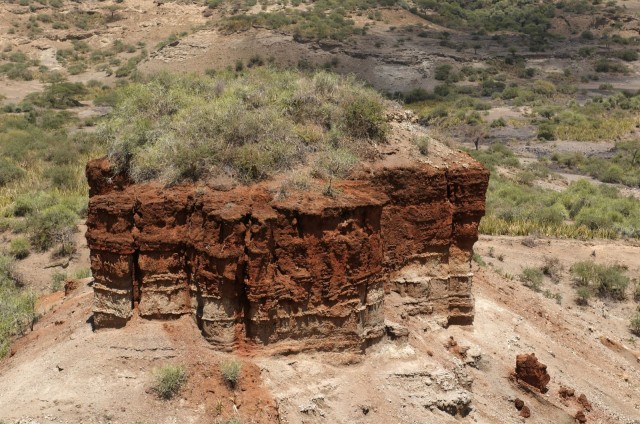Olduvai Gorge
OLDUVAI GORGE IS LOCATED in the East African Rift Valley of northeastern TANZANIA, on the eastern edge of the Serengeti Plain. Discoveries of fossils dating back 1.8 million years were made there by Louis and Mary Leakey, and Donald Johansen.
The gorge is now part of the Ngorongoro Conservation Area and lies just to the west of two lakes: Natron in the northeast and Eyasi in the south. Its original name was Oldupai, a Maasai word for the sisal plants that grew there.
The Olduvai Gorge extends for 31 mi (50 km), and its steep sides are up to 295 ft (90 m) high. It forms a Y shape, with a branch called the Side Gorge joining with the Main Gorge. Millions of years ago, volcanic eruptions set down the rocks and layered ash that would become Olduvai Gorge.

By 2 million years ago, the area was a shallow alkaline lake, an attractive, swampy habitat for many animal and plant species. About 1.5 million years ago, the area's climate changed drastically. The lake size lessened, and the fossil records show that species more adapted to a dry savanna moved into the area. Within the last 500,000 years, tectonic activity had created the Olbalbal Depression to the west of the lake, and at some point waters from the lake began to flow into the depression. The Olduvai Gorge was formed by the draining waters, which over millennia carved through the deposits of ash and fossils. Erosion exposed layers of the gorge that date to the lower Pleistocene Age, and have yielded archaeological finds up to 1.8 million years old.
Today, archaeologists divide the stratification into six areas, or beds, with Bed One being the oldest, closest to the basalt bedrock. Although fossils were first found in the area in 1911, nearly 50 years passed before its importance was realized. In 1959, Mary Leakey discovered the skull of a hominid over 1.8 million years old. Originally named Zinjantropus by the Leakeys, it is today called Australopithecus Boisei. In the 1960s, the Leakeys also found the first remains of Homo habilis, a 1.8-million-year-old hominid, possibly the first hominid to use the tools found at Olduvai Gorge. Both of these were found in Bed One, along with pebble tools.
In Bed Two, which dates to 500,000 years ago, the remains of Homo erectus have been found, along with hand axes. Remains of Homo sapiens (modern man) have been found in Bed Four.